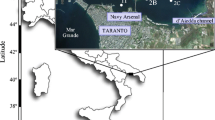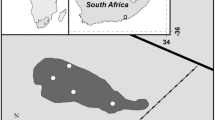Abstract
Carbon isotopic composition was used to assess the linkage between three different potential sources of energy and the community in the shallow coastal zone of Martel Inlet. Stable δ13C ratios ranged from −28.7‰ for the zooplankton plus phytoplankton to −14.4‰ for the grazer Nacella concinna. Microphytobenthos (−16.7‰) was considerably more enriched in 13C than were suspended particulate matter (SPM) (−25.6‰) and macroalgal fragments (−23.6‰ and −21.1‰), indicating that stable carbon isotope analysis might be used to discern the relative contribution of these sources of primary production. There is a benthic-pelagic coupling between plankton, benthic suspensivores, the ophiuroid Ophionotus victoriae and the icefish Chaenocephalus aceratus. Benthic grazers such as N. concinna, deposit feeders such as Yoldia eightsi and the nematodes showed a tight coupling with the microphytobenthos and the sediment. Some omnivorous/depositivorous polychaetes, echinoids, amphipods and the fish Notothenia coriiceps showed values close to the ratios of the macroalgal fragments. Benthic carnivores and/or scavengers were generally enriched over suspensivores and depleted in relation to microphytobenthos grazers, showing a considerable overlap in δ13C values throughout the food web, without any clear coupling with the primary sources of organic matter. The trophic web in the shallow zone of high benthic production and under seasonal ice cover in the Antarctic is more complex than it is in shelf areas, where SPM is the main food source. The soft-bottom community in the shallow zone of Martel Inlet is enriched in 13C due to the significant input of carbon from the microphytobenthos and macroalgal fragments.



Similar content being viewed by others
References
Ahn IY (1993) Enhanced particle flux through the biodeposition by the Antarctic suspension-feeding bivalve Laternula elliptica in Marian Cove, King George Island. J Exp Mar Biol Ecol 171:75–90
Arntz WE, Brey T, Gallardo VA (1994) Antarctic zoobenthos. Oceanogr Mar Biol Annu Rev 32:241–304
Atkinson EG, Wacasey JW (1987) Sedimentation in Arctic Canada: particulate organic carbon flux to shallow marine benthic community in Frobisher Bay. Polar Biol 8:3–7
Barrera-Oro ER, Casaux RJ (1990) Feeding selectivity in Notothenia neglecta, Nybelin, from Potter Cove, South Shetland Islands, Antarctica. Antarct Sci 2:207–213
Boutton TW (1991) Stable carbon isotope ratios of natural materials. I. Sample preparation and mass spectrometric analysis. In: Coleman DC, Fry B (eds) Carbon isotope techniques. Academic, New York, pp 155–171
Bromberg S, Nonato EF, Corbisier TN, Petti MAV (2000) Polychaetes distribution in the near-shore zone of Martel Inlet, Admiralty Bay (King George Island, Antarctica). Bull Mar Sci 67:175–188
Casaux R, Barrera-Oro E, Baroni A, Ramón A (2003) Ecology of inshore notothenioid fish from the Danco Coast, Antarctic Peninsula. Polar Biol 26:157–165
Couch CA (1989) Carbon and nitrogen stable isotopes of meiobenthos and their food resources. Estuar Coast Shelf Sci 28:433–441
Currin CA, Newell SY, Paerl HW (1995) The role of standing dead Spartina alterniflora and benthic microalgae in salt marsh food webs: considerations based on multiple stable isotope analysis. Mar Ecol Prog Ser 121:99–116
Dauby P, Scailteur Y, De Broyer C (2001) Trophic diversity within the eastern Weddell Sea amphipod community. Hydrobiologia 443:69–86
Davenport J (1988) The feeding mechanism of Yoldia (=Aequiyoldia) eightsi (Couthouy). Proc R Soc B 232:431–442
Dayton PK, Watson D, Palmisano A, Barry JP, Oliver JS, Rivera D (1986) Distribution patterns of benthic microalgal standing stock at McMurdo Sound, Antarctica. Polar Biol 6:207–213
Domaneschi O, Silva JRMC da, Porto Neto LR, Passos FD (2002) New perspectives on the dispersal mechanisms of the Antarctic brooding bivalve Mysella charcoti (Lamy, 1906). Polar Biol 25:538–541
Dunton KH (2001) δ15N and δ13C measurements of Antarctic peninsula fauna: trophic relationships and assimilation of benthic seaweeds. Am Zool 41:99–112
Dunton KH, Saupe SM, Golikov AN, Schell DM, Schonberg SV (1989) Trophic relationships and isotopic gradients among arctic and subarctic marine fauna. Mar Ecol Prog Ser 56:89–97
Fischer G (1991) Stable carbon isotope ratios of plankton carbon and sinking organic matter from the Atlantic sector of the Southern Ocean. Mar Chem 35:581–596
Fischer G, Wiencke C (1992) Stable carbon isotope composition, depth distribution and fate of macroalgae from the Antarctic Peninsula region. Polar Biol 12:341–348
France RL (1995) Carbon-13 enrichment in benthic compared to planktonic algae: foodweb implications. Mar Ecol Prog Ser 124:307–312
France R, Loret J, Mathews R, Springer J (1998) Longitudinal variation in zooplankton 13C through the Northwest Passage: inference for incorporation of sea-ice POM into pelagic foodwebs. Polar Biol 20:335–341
Fratt DB, Dearborn JH (1984) Feeding biology of the Antarctic brittle star Ophionotus victoriae (Echinodermata: Ophiuroidea). Polar Biol 3:127–139
Frazer TK (1996) Stable isotope composition (δ13C and δ15N) of larval krill, Euphausia superba, and two of its potential food sources in winter. J Plankton Res 18:1413–1426
Gambi MC, Castelli A, Guizzardi M (1997) Polychaete populations of the shallow soft bottoms off Terra Nova Bay (Ross Sea, Antarctica): distribution, diversity and biomass. Polar Biol 17:199–210
Gilbert NS (1991) Microphytobenthic seasonality in near-shore marine sediments at Signy Island, South Orkney Islands, Antarctica. Estuar Coast Shelf Sci 33:89–104
Grebmeier JM, Barry JP (1991) The influence of oceanographic processes on pelagic-benthic coupling in polar regions: a benthic perspective. J Mar Syst 2:495–518
Grebmeier JM, McRoy CP, Feder HM (1988) Pelagic-benthic coupling on the shelf of the northern Bering and Chukchi Seas. I. Food supply source and benthic biomass. Mar Ecol Prog Ser 48:57–67
Gutt J, Starmans A (1998) Structure and biodiversity of megabenthos in the Weddell and Lazarev seas (Antarctica): ecological role of physical parameters and biological interactions. Polar Biol 20:229–247
Hobson KA, Ambrose Jr WG, Renaud PE (1995) Sources of primary production, benthic-pelagic coupling, and trophic relationships within the Northest Water Polynya: insights from δ13C and δ15N analysis. Mar Ecol Prog Ser 128:1–10
Hodum PJ, Hobson KA (2000) Trophic relationships among Antarctic fulmarine petrels: insights into dietary overlap and chick provisioning strategies inferred from stable-isotope (δ15N and δ13C) analyses. Mar Ecol Prog Ser 198:273–281
Iken K, Quartino ML, Barrera-Oro E, Palermo J, Wiencke C, Brey T (1998) Trophic relations between macroalgae and herbivores. Ber Polarforsch 299:201–206
Iken K, Amsler CD, Hubbard JM, McClintock JB, Baker BJ (2001) Preliminary results on secondary metabolites from Antarctic brown algae and their ecological relevance. J Phycol 37:26–26
Jazdzewski K, Jurasz W, Kittel W, Presler E, Presler P, Sicinski J (1986) Abundance and biomass estimates of the benthic fauna in Admiralty Bay, King George Island, South Shetland Islands. Polar Biol 6:5–16
Kaehler S, Pakhomonov EA, McQuaid CD (2000) Trophic structure of the marine food web at the Prince Edward Islands (Southern Ocean) determined by δ13C and δ15N analysis. Mar Ecol Prog Ser 208:13–20
Kozlov AN, Pinskaya IA, Podrazhanskaya SG, Tarverdieva MI (1988) Feeding of glassfishes in different regions of the Atlantic sector of Antarctica. J Ichthyol 28:802–811
Linkowski TB, Presler P, Zukowski C (1983) Food habitats of nototheniid fishes (Nototheniidae) in Admiralty Bay (King George Island, South Shetland Islands). Pol Polar Res 4:79–95
Lipski M (1987) Variations of physical conditions, nutrients and chlorophyll a contents in Admiralty Bay (King George Island, South Shetland Islands, 1979). Pol Polar Res 8:307–332
Michener RH, Schell DM (1994) Stable isotopes ratios as tracers in marine aquatic foodwebs. In: Lajtha K, Michener RH (eds) Stable isotopes in ecology and environmental sciences. Blackwell, Oxford, pp 138–157
Mills EL, Pittman K, Tan FC (1984) Food-web structure on the Scotian Shelf, eastern Canada: a study using 13C as a food-chain tracer. Rapp P-V Réun Cons Int Explor Mer 183:111–118
Nonato EF, Brito TAS, Paiva PC, Petti MAV (1992) Programa Antártico Brasileiro: Projeto “Bionomia da fauna bentônica Antártica”. Atividades subaquáticas realizadas na Baía do Almirantado a partir da VI Expedição (1988). Relat Int Inst Oceanogr Univ São Paulo 33:1–12
Nonato EF, Brito TAS, Paiva PC, Petti MAV, Corbisier TN (2000) Benthic megafauna of the nearshore zone of Admiralty Bay (King George Island, South Shetland Islands, Antarctica): depth zonation and underwater observations. Polar Biol 23:580–588
Peck LS, Bullough LW (1993) Growth and population structure in the infaunal bivalve Yoldia eightsi in relation to iceberg activity at Signy Island, Antarctica. Mar Biol 117:235–241
Perissinotto R, Pakhomov EA, McQuaid CD, Froneman PW (1997) In situ grazing rates and daily ration of Antarctic krill Euphausia superba feeding on phytoplankton at the Antarctic Polar Front and the Marginal Ice Zone. Mar Ecol Prog Ser 160:77–91
Petersen GH, Curtis MA (1980) Differences in energy flow through major components of subarctic, temperate and tropical marine shelf ecosystems. Dana 1:53–64
Picken GB (1980) Reproductive adaptation of Antarctic benthic invertebrates. Biol J Linn Soc 14:67–75
Presler P (1986) Necrophagous invertebrates of the Admiralty Bay of King George Island (South Shetland Islands, Antarctica). Pol Polar Res 7:25–61
Rakusa-Suszczewski S (1995) The hydrography of Admiralty Bay and its inlets, coves and lagoons (King George Island, Antarctica). Pol Polar Res 16:61-70
Rau GH, Sweeney RE, Kaplan IR (1982) Plankton 13C:12C ratio changes with latitude: differences between northern and southern oceans. Deep-Sea Res 29:1035–1039
Rau GH, Takahashi T, Des Marais DJ (1989) Latitudinal variation in plankton δ13C: implications for CO2 and productivity in past oceans. Nature 341:516–518
Rau GH, Takahashi T, Des Marais DJ, Sullivan CW (1991a) Particulate organic matter δ13C variations across the Drake Passage. J Geophys Res 96:15131–15135
Rau GH, Hopkins TL, Torres JJ (1991b) 15N/14N and 13C/12C in Weddell Sea invertebrates: implications for feeding diversity. Mar Ecol Prog Ser 77:1–6
Riera P, Richard P, Grémare A, Blanchard G (1996) Food source of intertidal nematodes in the Bay of Marennes-Oléron (France), as determined by dual stable isotope analysis. Mar Ecol Prog Ser 142:303–309
Sackett WM, Eadie BJ, Exner ME (1974) Stable isotope composition of organic carbon in recent antarctic sediments. In: Tissot B, Bienner F (eds) Advances in organic geochemistry. Editions Technip, Paris, pp 661–671
Skowronski RSP (2002) Distribuição espacial e variação temporal da meiofauna, com ênfase para o grupo Nematoda, na Enseada Martel (Antártica). PhD thesis, University of São Paulo
Skowronski RSP, Corbisier TN (2002) Meiofauna distribution in Martel Inlet, King George Island (Antarctica): sediment features versus food availability. Polar Biol 25:126–134
Skowronski RSP, Corbisier TN, Robles FR (1998) Meiofauna along a coastal transect in Admiralty Bay, King George Island (Antarctica). Pesq Antárt Bras 3:1–16
Thompson PA, Calvert SE (1994) Carbon-isotope fractionation by a marine diatom: the influence of irradiance, daylength, pH, and nitrogen source. Limnol Oceanogr 39:1835–1844
Wada E, Terazaki M, Kabaya Y, Nemoto T (1987) 15N and 13C abundances in the Antarctic Ocean with emphasis on the biogeochemical structure of the food web. Deep-Sea Res 34:829–841
Wägele JW, Brito TAS (1990) Die sublitorale fauna der maritimen Antarktis Erste unterwasserbeobachtungen in der Admiralitäsbucht. Natur Mus 120:269–304
Wassman P (1991) Dynamics of primary production and sedimentation in shallow fjords and polls of western Norway. Oceanogr Mar Biol Annu Rev 29:87–154
Acknowledgements
This research project was made possible through support provided by the CNPq (Conselho Nacional de Pesquisa e Desenvolvimento), SeCIRM (Secretaria da Comissão Interministerial para os Recursos do Mar), under the scope of PROANTAR (Brazilian Antarctic Program) and the Instituto Oceanográfico, Universidade de São Paulo. Special thanks are due to the Volkswagen Foundation for the donation of the diving gear and to Luciano C. Candisani for the help given with the diving, and to Marizilda Magro for the drawings. We also thank Dr Claude De Broyer for his valuable help and two anonymous reviewers for their comments.
Author information
Authors and Affiliations
Corresponding author
Rights and permissions
About this article
Cite this article
Corbisier, T.N., Petti, M.A.V., Skowronski, R.S.P. et al. Trophic relationships in the nearshore zone of Martel Inlet (King George Island, Antarctica): δ13C stable-isotope analysis. Polar Biol 27, 75–82 (2004). https://doi.org/10.1007/s00300-003-0567-z
Received:
Accepted:
Published:
Issue Date:
DOI: https://doi.org/10.1007/s00300-003-0567-z




